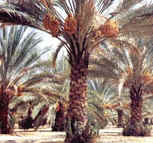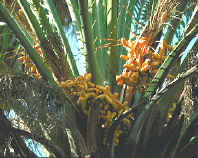Dates
Information about Dates plus Dates Recipes
Collection
|
Ingredient of the
Month
|
Scroll
down for Date recipes
|
January
2003 |
Click
here for more Ingredients of the Month
 Dates
are the fruit of the date Palm, Phoenix dactylifera which belongs to
the family Areaceae,. Dactylifera is Greek word for �finger-bearing�.
The English word date derives from the Greek �dactylus� and Hebrew
�dachel� which both mean finger. The fruit is a �drupe�
with a single seed in each. They are borne on clusters often weighing 10 kg or
more. They contain several minerals including potassium, phosphorus,
calcium and magnesium, vitamins such as riboflavin, thiamine, folic
and ascorbic acid, fats and easily digested sugars (glucose, sucrose and
fructose). Dates
are the fruit of the date Palm, Phoenix dactylifera which belongs to
the family Areaceae,. Dactylifera is Greek word for �finger-bearing�.
The English word date derives from the Greek �dactylus� and Hebrew
�dachel� which both mean finger. The fruit is a �drupe�
with a single seed in each. They are borne on clusters often weighing 10 kg or
more. They contain several minerals including potassium, phosphorus,
calcium and magnesium, vitamins such as riboflavin, thiamine, folic
and ascorbic acid, fats and easily digested sugars (glucose, sucrose and
fructose).
Origin
and History of Dates
 The
date palm is probably the oldest tree cultivated by man. Dates
have been cultivated and traded from as early as 5000 BC and whilst dates
were revered by many cultures, the Arabs seem to be the ones who hold it in the
greatest esteem. Indeed, it is historically known that desert people, in
particular the nomadic Bedouins, lived on dates and camel milk for months on
end. The
date palm is probably the oldest tree cultivated by man. Dates
have been cultivated and traded from as early as 5000 BC and whilst dates
were revered by many cultures, the Arabs seem to be the ones who hold it in the
greatest esteem. Indeed, it is historically known that desert people, in
particular the nomadic Bedouins, lived on dates and camel milk for months on
end.
Evidence
that the fruit was traded between India and the Arabian Peninsula dates back to
the 1st Millennia BC, via the already established Frankincense and Myrrh
trade routes.
It
is easy to see how the use of this incredible fruit spread throughout the world;
once dried, they are light to carry, self preserving (containing a high
proportion of sugar) and with the nutritional attributes mentioned above, can be
used as a major food source for dessert people, sailors on long voyages and
armies as well as livestock.
Cultivation, Processing
and Growing Dates
Many
people will have heard of the large Majool Date which is mainly grown in Morocco,
but there are others including Barhee, Khalas, Zaghloul,
Naghal and Jaberi Fardh. They all differ in colour, sweetness and texture.
All in all there are over 600 varieties of dates grown world- wide .
Date
Palms are dioecious that is to say there are male and female plants. It only
requires one male plant to every 40 or so female trees to produce good
crops when grown on a plantation. Now grown in
tropical and sub tropical regions as well as in temperate regions in USA,
Australia, and Mediterranean areas, most start to produce fruit at
about 6 years but reach maturity at about 30 years and continue to produce dates
for a further 70 years or so.
 The
spathes containing pollen on the male trees appear in early spring when
pollination takes place. The low level of fertilization obtained by wind
or insects would certainly be insufficient for commercial production, so man
assisted pollination takes place on plantations using both hand and mechanical
blowers. During the growing period, the fruit which is borne in clusters, may be
thinned to produce larger, better quality fruit. This is also done by
hand. The
spathes containing pollen on the male trees appear in early spring when
pollination takes place. The low level of fertilization obtained by wind
or insects would certainly be insufficient for commercial production, so man
assisted pollination takes place on plantations using both hand and mechanical
blowers. During the growing period, the fruit which is borne in clusters, may be
thinned to produce larger, better quality fruit. This is also done by
hand.
Depending
on the variety, "fresh" dates are harvested 3-5 months after
pollination, when they have slightly dried, coloured and ripened and have a
moisture content of 35-40%. However it takes about 200 days for the
fruit to reach the Tamr stage at which point the date has only 20- 24%
moisture content. These are the fruit which are used for packaging or further
processing . Once the dates are cleaned and sorted, some are
packaged as they are and others are pitted and made into a variety of products
such as pastes, liquid sugar, and date syrup.
Cooking with Dates
Dates
can be used in a variety of both sweet and savoury recipes. When used in their
dried form, they add a richness and sweetness unrivalled by most other dried
fruit. They are particularly popular in middle eastern and North African
cuisine.
|
|

 Dates
are the fruit of the date Palm, Phoenix dactylifera which belongs to
the family Areaceae,. Dactylifera is Greek word for �finger-bearing�.
Dates
are the fruit of the date Palm, Phoenix dactylifera which belongs to
the family Areaceae,. Dactylifera is Greek word for �finger-bearing�. The
date palm is probably the oldest tree cultivated by man. Dates
have been cultivated and traded from as early as 5000 BC and whilst dates
were revered by many cultures, the Arabs seem to be the ones who hold it in the
greatest esteem. Indeed, it is historically known that desert people, in
particular the nomadic Bedouins, lived on dates and camel milk for months on
end.
The
date palm is probably the oldest tree cultivated by man. Dates
have been cultivated and traded from as early as 5000 BC and whilst dates
were revered by many cultures, the Arabs seem to be the ones who hold it in the
greatest esteem. Indeed, it is historically known that desert people, in
particular the nomadic Bedouins, lived on dates and camel milk for months on
end. The
spathes containing pollen on the male trees appear in early spring when
pollination takes place. The low level of fertilization obtained by wind
or insects would certainly be insufficient for commercial production, so man
assisted pollination takes place on plantations using both hand and mechanical
blowers. During the growing period, the fruit which is borne in clusters, may be
thinned to produce larger, better quality fruit. This is also done by
hand.
The
spathes containing pollen on the male trees appear in early spring when
pollination takes place. The low level of fertilization obtained by wind
or insects would certainly be insufficient for commercial production, so man
assisted pollination takes place on plantations using both hand and mechanical
blowers. During the growing period, the fruit which is borne in clusters, may be
thinned to produce larger, better quality fruit. This is also done by
hand.